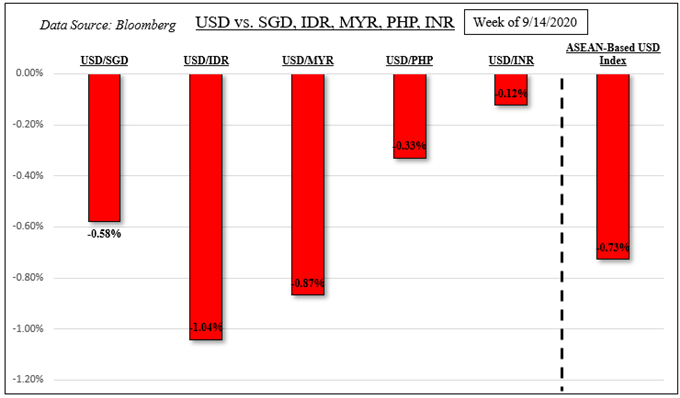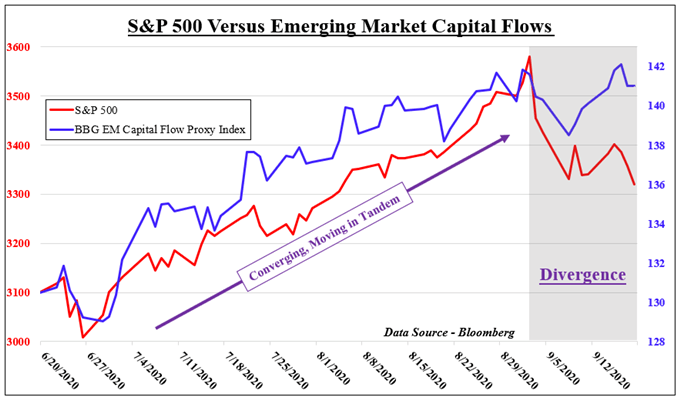US Dollar, Singapore Dollar, Indonesian Rupiah, Philippine Peso, Malaysian Ringgit – Talking Points
- US Dollar struggling versus ASEAN FX despite weakness in the S&P 500
- Has risk aversion materially shifted capital flows into emerging markets?
- Could further weakness in US equities spillover outwards, boosting USD?
US Dollar ASEAN Weekly Recap
The haven-linked US Dollar underperformed its ASEAN counterparts such as the Singapore Dollar, Malaysian Ringgit, Indonesian Rupiah and Philippine Peso. This is despite a third consecutive week of losses in the S&P 500. Investors often look to the world’s largest economy as a bellwether for the shape of global growth. Thus, weakness in equities there can sometimes spread outward. What might explain this deviation?
Notable standouts this past week were the Malaysian Ringgit and Indonesian Rupiah. USD/MYR fell 0.94% in the best 5-day performance in 6 weeks. USD/IDR dropped 1.40%, the most since the beginning of June. As expected, the Indonesian Central Bank strengthened its tone towards intervening in the foreign exchange market to uphold the value of IDR. That likely played a key roll in giving its currency some strength.



Last Week’s US Dollar Performance

*ASEAN-Based US Dollar Index averages USD/SGD, USD/IDR, USD/MYR and USD/PHP
S&P 500 Versus Emerging Market Capital Flows
Capital flows can often have a key role in driving SGD, IDR, MYR and PHP. On the next chart below, while the S&P 500 can be seen taking a dip since late August, capital continues to flow into emerging market economies. Typically, these two tend to move in tandem, meaning that as the S&P 500 rises or falls, the latter tends to follow. While correlation can be positive, it does not imply causation.
The recent divergence between the two could suggest that the fundamental forces driving equities lower in the United States might be perceived as carrying less knock-on consequences for global financial markets. This may be caused by a combination of rising concern over tech stock valuations, of which are a key component of American benchmark stock indexes, and perhaps political uncertainty ahead of the presidential election.

External Event Risk – US Markit PMIs, New Home Sales, Durable Goods Orders
With that in mind, the US Dollar could struggle to catch a bid against ASEAN currencies, keeping USD/SGD, USD/IDR, USD/MYR and USD/PHP from pushing too much higher. Yet, investors ought to not discount the possibility that a slowdown in the US reverberates outward. The Citi Economic Surprise Index tracking the US is at its lowest since late June, extending the top from historical peaks in July.
While the value is still positive, its shrinkage suggests that economists’ expectations are slowly closer aligning to reality, and that same level of pessimism in forecasts is fading. The decreasing tendency for economic data to surprise to the upside could be a warning sign that the road ahead will be increasingly tougher. That may in turn offer a path for the Greenback to find a bottom as investors assess the stalling of growth.
Taking this into account, Markit US PMI data may be closely eyed on Wednesday for further signs into the country’s recovery. This will then be followed by initial jobless claims and new home sales on Thursday, wrapping up with durable goods orders on Friday. Disappointing outcomes here could offer some support to the haven-oriented US Dollar.



ASEAN, South Asia Event Risk – Singapore Industrial Production, Malaysian CPI
Focusing on ASEAN event risk, Singapore industrial production on Friday may offer insight into how global growth is performing. That is because the nation is heavily reliant on the external sector. But, USD/SGD may focus on external risks. The Malaysian Ringgit may also look past local CPI data on Wednesday. The Bank of Malaysia last left rates on hold, anticipating inflation to pick up in 2021 is 2020 pressures remain muted.
On September 18th, the 20-day rolling correlation coefficient between my ASEAN-based US Dollar index and my Wall Street index was 0.02 versus -0.67 from one week ago. Values closer to -1 indicate an increasingly inverse relationship, though it is important to recognize that correlation does not imply causation.
ASEAN-Based USD Index Versus Wall Street Index – Daily Chart

Chart Created Using TradingView
*ASEAN-Based US Dollar Index averages USD/SGD, USD/IDR, USD/MYR and USD/PHP
*Wall Street Index averages S&P 500, Dow Jones and Nasdaq 100 futures
-- Written by Daniel Dubrovsky, Currency Analyst for DailyFX.com
To contact Daniel, use the comments section below or @ddubrovskyFX on Twitter






